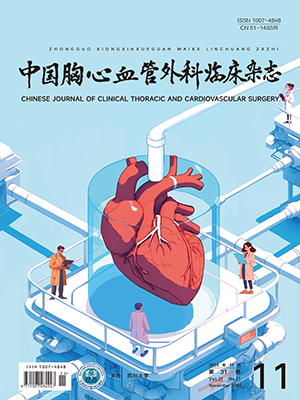Abstract: Objective To summarize the clinical experiences of videoassisted thoracoscopic surgery (VATS) lobectomy performed on a series of 300 consecutive patients, and report the results of a 3year followup. Methods We retrospectively analyzed the clinical data of 300 consecutive patients who underwent VATS lobectomy from September 2006 to December 2009 in the Department of Thoracic Surgery, People’s Hospital of Peking University. Of the 300 patients, there were 159 males and 141 females with the age ranged from 18 to 86 years (58.30±13.90 years). Preoperative diagnosis showed that there were 266 patients of mass in the lung, 22 of bronchiectasis, 5 of cyst/abscess in the lung, 3 of pulmonary sequestration, 2 of fungus infection, and 2 of pneumothorax. We assessed the perioperative variables by standard descriptive statistics and estimated the 3year survival rate by KaplanMeier analyses. Results Sixtysix patients were diagnosed to have benign diseases and 234 patients were with malignancies. A percentage of 81.82% (54/66) of the benign patients had infectious diseases, and the majority of the malignancies was nonsmall cell lung cancer (213 patients), especially adenocarcinomas which comprised 73.08% (171/234) of all the malignancies. A total of 273 patients accomplished VATS lobectomy, of whom 27 patients required conversion to thoracotomy at a conversion rate of 9.00%(27/300). In the VATS lobectomy accomplished group, the mean operation time was 317±088 h, and the blood loss was 225.70±195.20 ml. Benign surgery took significantly less time (t=2.280, P=0.0032) and had shorter drainage time(t=1.392, P=0.0304) than those of malignancies. Dense adhesions between lymph nodes and blood vessels was the primary reason for conversion to thoracotomy in 17 patients at a percentage of 62.96%(17/27). Bleeding was the second reason for conversion in 5 patients at a percentage of 1852%. The patients in the upper lobe lobectomy group showed significantly higher risk of conversion compared with those in the nonupper lobe surgery group (χ2=6.131, P=0.013), while gender (χ2=1.182, P=0.277), pathology (χ2=0.210, P=0.647) and the tumor located in left or right side(χ2=2.933, P=0.087) didn’t influence the risk of conversion. The result of the 3year followup showed that there was no reoccurrence of symptoms in patients with benign diseases; Nonsmall cell lung cancer patients had a 3year survival rate of 0.87 with the 95% confidence interval (CI) from 0.77 to 0.96, and pathologic stage I patients at 0.91 with the 95%CI from 0.85 to 0.98. Conclusion VATS lobectomy is safe and effective. This research shows that domestic technologies of VATS lobectomy and its midterm results have reached the international standard.
Citation: YANG Fan,LI Xiao,WANG Jun,et al .. Videoassisted Thoracoscopic Surgery Lobectomy: a Series of Consecutive 300 Patients and a 3year Follow-up. Chinese Journal of Clinical Thoracic and Cardiovascular Surgery, 2011, 18(2): 95-98. doi: Copy




